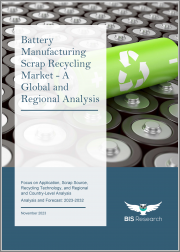
세계의 배터리 제조 스크랩 재활용(Battery Manufacturing Scrap Recycling) 시장 규모는 2022년 19억 6,000만 달러에서 예측 기간 동안 16.89%의 CAGR로 성장을 지속하여 2032년에는 106억 3,000만 달러 규모에 달할 것으로 예측됩니다.
배터리 제조 스크랩 재활용은 배터리 셀 제조 과정에서 발생하는 스크랩 재료의 제조를 다루는 급성장 산업입니다. 전기 자동차의 보급에 따라 이러한 배터리 시장은 급속히 확대될 것으로 예상되고, 배터리 제조 스크랩 재활용 기술의 확대에도 박차가 걸릴 것으로 생각되고 있습니다. 배터리 제조 스크랩 재활용 시장을 독점하고 있는 것은 Umicore, BASF SE, Tenova SpA 등의 주요 기업 몇사가 존재하지만, 향후 수년 중에는 다수의 경쟁사가 시장에 진입해, 경쟁이 격화해, 한층 더 성장과 혁신에 박차를 가할 것으로 예상됩니다.
| 주요 시장 통계 | |
|---|---|
| 예측 기간 | 2023-2032년 |
| 2023년 평가 | 26억 1,000만 달러 |
| 2032년 예측 | 106억 3,000만 달러 |
| CAGR | 16.89% |
스크랩 발생원별로 보면, 자동차용 배터리의 부문이 2022년 시장을 독점했습니다. 또한 재활용 기술별로는 습식 야금 부문이 2022년 시장을 독점했습니다. 습식 야금은 가장 중요한 재활용 기술 중 하나이며 주요 산업 응용 분야의 요구 사항을 충족합니다. 게다가 지역별로는 중국이 2022년 시장에서 약 24.8%의 점유율을 차지해 지배적인 지역이 되었습니다.
|
|
세계 배터리 제조 스크랩 재활용 시장을 조사했으며, 시장 배경·개요/시장 성장에 대한 각종 영향 요인 분석/특허 동향/시장 규모 추이 및 예측/각종 구분·지역 및 주요 국가별의 상세 분석/경쟁 구도/주요 기업 분석 등을 정리했습니다.
“Global Battery Manufacturing Scrap Recycling Market Expected to Reach $10.63 Billion by 2032.”
The global battery manufacturing scrap recycling market was valued at $1.96 billion in 2022, and it is expected to grow at a CAGR of 16.89% to reach $10.63 billion by 2032. The battery manufacturing scrap recycling is a fast-expanding industry that deals with the manufacturing of scrap materials generated during the manufacturing process of battery cells. The market for these batteries is anticipated to expand rapidly as electric vehicles gain popularity, which will also fuel the expansion of the battery manufacturing scrap recycling technologies. In addition, there are a few key players who dominate the battery manufacturing scrap recycling market, including Umicore, BASF SE, Tenova S.p.A., and many more. Nonetheless, a large number of new competitors are anticipated to enter the market in the upcoming years, increasing competition and spurring additional growth and innovation.
| KEY MARKET STATISTICS | |
|---|---|
| Forecast Period | 2023 - 2032 |
| 2023 Evaluation | $2.61 Billion |
| 2032 Forecast | $10.63 Billion |
| CAGR | 16.89% |
The global battery manufacturing scrap recycling market is in a growing phase. New trends, such as targets for ethical supply chain and decarbonization, increasing focus toward secondary battery materials, rising investments in recycling technologies, change in business models of companies due to climate action, increasing demand for lithium-ion batteries and raw materials across the value chain, and development of economic and environmental technologies, are further expected to provide opportunities for the market to grow in the coming years.
Battery manufacturing scrap recycling market has a large industry influence since it provides numerous environmental and economic benefits. Furthermore, it has a significant effect on end-use sectors since it provides a plethora of benefits that can increase their efficiency, lower their costs, and give them a consistent source of important metals.
With an increased worldwide focus on circular economic principles and the advancements in recycling technologies for the recovery of high-performance metals from manufacturing scrap, there is an increasing shift toward the demand and consumption of batteries such as lithium-ion in the end-use industries. Thereby creating demand for the recycling of battery manufacturing scrap. Additionally, the shift is more prominent in the automotive and energy sectors in regions such as China, Asia-Pacific and Japan, North America, and Europe.
Based on the scrap source, the automotive batteries segment dominated the global battery manufacturing scrap recycling market in 2022.
Based on the recycling technology, the hydrometallurgy segment dominated the global battery manufacturing scrap recycling market in 2022. It is one of the most significant recycling technologies, which meets the requirements of major industrial application areas.
Based on the application, the automotive segment dominated the global battery manufacturing scrap recycling market in 2022.
Based on region, in 2022, China was the dominant region, accounting for a share around 24.8% of the global battery manufacturing scrap recycling market.
Following are the drivers for the global battery manufacturing scrap recycling market:
Following are the challenges for the global battery manufacturing scrap recycling market:
Product/Innovation Strategy: The product segment helps the reader understand the different sources from where the batteries are coming for recycling and reaching their best potential globally. Moreover, the study provides the reader with a detailed understanding of the different battery chemistries and their assortments in different batteries employed in various end-use applications in industries such as aerospace, automotive, energy, and sports.
Growth/Marketing Strategy: Business expansions, partnerships, acquisitions, collaborations, and joint ventures are some key strategies adopted by key players operating in this market. For instance, in April 2022, in Europe, Umicore and Automotive Cells Company (ACC) formed a strategic cooperation for EV battery materials. With the first commercial volumes anticipated in early 2024, the long-term arrangement will begin with an annual offtake commitment of 13 GWh to a significant platform of a European automaker.
Competitive Strategy: Key players in the global battery manufacturing scrap recycling market analyzed and profiled in the study involve battery manufacturing scrap recycling providers. Moreover, a detailed competitive benchmarking of the players operating in the global battery manufacturing scrap recycling industry has been done to help the reader understand how players stack against each other, presenting a clear market landscape. Additionally, comprehensive competitive strategies such as partnerships, agreements, and collaborations will aid the reader in understanding the untapped revenue pockets in the market.
The companies profiled have been selected based on inputs gathered from primary experts and analyzing the company's coverage, product portfolio, and market penetration.
|
|